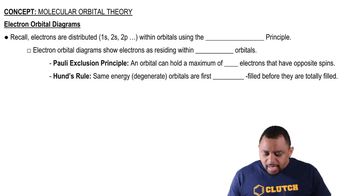Here are the essential concepts you must grasp in order to answer the question correctly.
Orbital Diagrams
Orbital diagrams are visual representations of the electron configuration of an atom. They illustrate the distribution of electrons among the various orbitals, which are regions of space where electrons are likely to be found. Each orbital can hold a maximum of two electrons, and the diagrams help in understanding how electrons fill these orbitals according to the principles of quantum mechanics.
Recommended video:
Electron Orbital Diagrams
Half Arrows in Orbital Diagrams
In orbital diagrams, half arrows represent individual electrons within the orbitals. Each arrow points either up or down, indicating the spin of the electron, which can be either 'up' (spin +1/2) or 'down' (spin -1/2). This notation is crucial for adhering to the Pauli Exclusion Principle, which states that no two electrons in an atom can have the same set of quantum numbers.
Recommended video:
Electron Orbital Diagrams
Direction of the Arrow
The direction of the half arrow in an orbital diagram signifies the spin of the electron. An upward-pointing arrow represents an electron with a positive spin, while a downward-pointing arrow indicates a negative spin. This distinction is important for understanding the behavior of electrons in magnetic fields and their overall contribution to the atom's magnetic properties.
Recommended video:
Chemical Equilibrium Concepts



